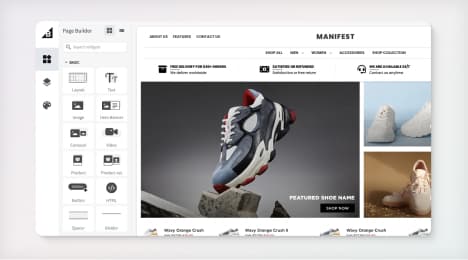
Watch Our Product Tour
See how BigCommerce helps you build and manage your online store with ease.
- Ecommerce Insights

6 Key Steps to Launch Your Online Store
Explore our Launch Foundations series to get your BigCommerce store up and running quickly.
BigCommerce helps growing businesses, enterprise brands, and everything in-between sell more online.
What is Amazon Advertising?
Amazon is one of the biggest marketplaces. It’s so popular among online shoppers that some of them are so loyal to Amazon that they won’t even consider purchasing products off the platform.
Amazon’s leading position goes hand in hand with high competition among Amazon sellers. Thus, Amazon Advertising is growing and sellers need a strategic and flexible advertising plan that will bring them the best possible ROI.
Defined: Amazon Advertising
Amazon Advertising (formerly AMS or Amazon Marketing Services) is a service that works in a similar way to pay-per-click ads on Google: sellers only pay when shoppers click on ads (regardless of whether or not the item sells).
Amazon’s advertising business is growing at a rapid pace, especially as it diversifies its products across its ecosystem. Amazon DSP (Demand Side Platform) has allowed sellers to programmatically buy display and video ads at scale and target audiences on Amazon.com, Fire TV Sticks, IMDb.com, Kindles, Freedive, apps, third-party sites, apps and platforms.
Benefits of Amazon Advertising
Advertising on Amazon comes with many benefits:
The quality, brand-safe environment that advertisers want
Reducing the sales cycle
Improving sales history & product visibility
Improving brand awareness
Gaining valuable insights on changing consumer habits & optimizing campaigns to reach a more targeted audience
Tons of shopping journey data about who your shoppers are and how they shop
Learning the best ways to acquire customers at a given time
Tracking your results & being able to make data-driven decisions.
Amazon’s Advertising Model
Amazon Advertising is a pay-per-click model (PPC) that differs from some other marketplaces, e.g. Promoted Listings on eBay supports the PPS (pay-per-sale) funding model.
Relationship Between Ads and Organic Search on Amazon
There’s a relationship between ads and organic search on Amazon. The platform’s goal is to make sales by showing high-converting and best-selling products relevant to the query. So Amazon wants to prioritize the products that are likely to sell the most, i.e. products with good sales and feedback history.
So when sales and the amount of feedback improve, products climb in organic rankings. To learn more, download the full Amazon Advertising Guide.
Types of Amazon Ads
When selecting types of ads for campaigns, Amazon sellers have a variety of ad formats and placements to choose from, e.g. Amazon Sponsored Product, Sponsored Brand and so on. Below you’ll find more information about given ad types.
1.Sponsored Products.
Sponsored Products are the standard product listings that appear on the search results and product detail pages. They’re pay-per-click, keyword-targeted display ads for individual products. The link leads to the product details listing page.
To measure the performance of your Sponsored Product Ads, use a reporting tool that displays your ads' clicks, spend, sales and advertising cost of sales (ACoS).
2. Sponsored Brand Campaigns.
Sponsored Brand Campaigns enable you to promote keyword-targeted ads of multiple products above, below, and alongside search results. They’re based on a pay-per-click, auction-based pricing model. You can direct the shopper specifically to your customized product page or your Amazon Store.
You can feature up to three unique products in your ads, customize and test your ads' image, headline and landing page.
To check the performance of your advertisements, there’s a reporting feature that displays your ads' clicks, spend, sales, estimated win rate for keywords and ACoS (Advertising Cost of Sales).
3. Product Display Ads.
Product Display Ads are pay-per-click ads whose main objective is to cross-sell or upsell to your customers. This type of inventory, unlike the rest, is available to all advertisers, not just those selling on the platform. Amazon breaks down this category into display, video and custom.
Display ads appear on product detail pages, customer review pages, on top of the offer listing page and below search results. You can also find them on abandoned cart emails, follow-up emails, and recommendations emails.
To measure your performance, you can use a reporting tool that displays your campaigns' clicks, spend, sales, advertising cost of sales (ACoS), detail page views, average cost-per-click (ACPC), etc.
4. Video Ads.
Video Ads can be placed on Amazon-owned sites like Amazon.com and IMDb, Amazon devices like Fire TV and various properties across the web. To buy Amazon video ads, you don’t have to sell products on Amazon.
5. Amazon Stores.
Users can promote their product or brand on their own multi-page Amazon Store. Brands get an Amazon URL and can view traffic analytics.
6. Amazon Native Ads.
Amazon Native Ads can be placed on a brand's own website. These include recommendation ads, search ads and custom ads.
Amazon Advertising Plan in a Nutshell
Set up your goals, e.g. do you want to drive more sales or improve brand awareness? On Amazon you can align your targets with your goals, e.g. your Advertising Cost of Sales (ACoS) can be your metric of success if you're set on driving more sales.
Select the right products to advertise. Your most popular products along with competitive prices have the biggest potential for sales conversions.
Create clear, concise and persuasive product pages. Include accurate and descriptive titles, useful and relevant product information and high-quality images.
Plan, act and test what works & what doesn’t. For example, try out different ad types, experiment with keywords, target demographics and content. Then allocate the rest of the budget where the sweet spot lies.
Keep track of changes: changes and updates are constantly happening on Amazon. Additionally, different trends are gaining traction all the time. Even if your current campaign is working well today, you must stay flexible and review your ads regularly.
Consider markets with lower competition and lower CPCs (cost-per-click) & better return on advertising spend. These can be international markets where local online sellers aren’t able to offer specific products or meet the local demand.
Conclusion
The constantly growing ecommerce industry and the ever-increasing competition are driving digital ad spend on marketplaces. Thus, Amazon’s advertising business is growing at a rapid pace, especially as it diversifies its ad products across its ecosystem.
Advertising on Amazon comes with both opportunities and challenges. As a result, sellers need a strategic and flexible advertising plan to stand out in an overcrowded market. They also need to stay adaptable in the fast-changing marketplace reality.
BigCommerce helps growing businesses, enterprise brands, and everything in-between sell more online.
Start growing your ecommerce business even faster.
High-volume or established business? Request a demo